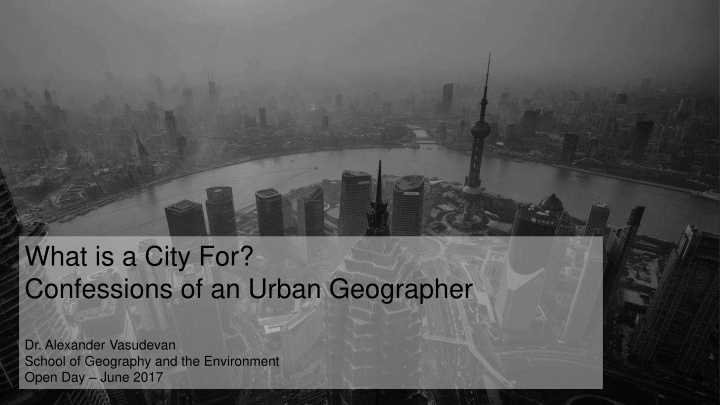



What is a City For? Confessions of an Urban Geographer Dr. Alexander Vasudevan School of Geography and the Environment Open Day – June 2017
Dr. Alexander Vasudevan Trained as a Human Geographer Associate Professor of Human Geography (University of British Columbia) Tutorial Fellow, Christ Church Studies Cities Research focuses on: Contemporary Urbanisation Social Movements and Urban Protest Cultural and Historical Geography of Cities Cultural Geographies of Artistic Practice
The ‘Urban Age’
“I’ll begin with the following hypothesis: Society has been completely urbanised. This hypothesis implies a definition: An urban society is a society that results from a process of complete urbanisation. This urbanisation is virtual today, but will become real in the future .” - Henri Lefebvre, The Urban Revolution (1970: 1)
‘The Urban Explosion’ “The universalization of urbanism is a new fact. Before the year 2000, for the first time in the history of humanity, the world will have more town dwellers than country dwellers . . . This demographic and urban evolution is taking place in the context of an economic crisis and the imbalance in population distribution will be accompanied by an increasing gap in the distribution of wealth” (UN report, 1984)
“ Sometimes it takes just one human being to tip the scales and change the course of history. In the year 2007, that human being will either move to a city or be born in one. Demographers watching urban trends will mark it as the moment in which the world entered a new millennium, a period in which, for the first time in history, the majority of the world’s people will live in cities” (UN -Habitat, 2007: 1).
“Given that more than half the world’s population is now living in cities — a number that is likely to reach 75 percent by 2050, while it was only 10 percent in 1900 — [ … ] urban questions have become truly global ones, with significant consequences for the future of our planet” (Burdett and Rode, 2006: 8). From the LSE-Deutsche Bank project, The Urban Age
• In 1990, 43 percent (2.3 billion) of the world’s population lived in urban areas; by 2015, this had grown to 54 percent (4 billion). • In 1995, there were 22 large cities, and 14 megacities; by 2015, there were 44 large cities and 29 megacities. (UN, World Cities Report, 2016)
The City in an Age of Planetary Urbanisation “During the last thirty years, however, the form of urbanisation has been radically reconfigured” (Brenner and Schmid, 2013: 11) “The city is everywhere and in everything” (Amin and Thrift, 2002: 1) What is a city … . For? Discrete entity Process of urbanisation
The City in an Age of Planetary Urbanisation
The City in an Age of Planetary Urbanisation Cities and Global finance
The City in an Age of Planetary Urbanisation Cities and Global finance Globalisation as Financialisation
The City in an Age of Planetary Urbanisation Cities and Habitation
The City in an Age of Planetary Urbanisation Cities and Habitation The ’housing question’: affordability and insecurity
The City in an Age of Planetary Urbanisation Cities as insecure places
The City in an Age of Planetary Urbanisation Cities as insecure places The Precarious City?
The City in an Age of Planetary Urbanisation Cities as sites of resistance
The City in an Age of Planetary Urbanisation Cities as sites of resistance The New Urban Revolutions
The City in an Age of Planetary Urbanisation Cities as ‘stuff’
The City in an Age of Planetary Urbanisation Cities as ‘stuff’ Urban Infrastructure and the Making of Cities
The City in an Age of Planetary Urbanisation Cities as creative places
The City in an Age of Planetary Urbanisation The city as site of creativity, experimentation and innovation Cities as creative places
The City in an Age of Planetary Urbanisation Cities as sanctuaries
The City in an Age of Planetary Urbanisation Citizens, Refugees, Strangers in the Contemporary City Cities as sanctuaries
The City in an Age of Planetary Urbanisation Cities and environmental change
The City in an Age of Planetary Urbanisation Future-Proofing Cities Cities and environmental change
Concluding Thoughts • The city has become a key site of investigation for geographers • What the city is remains a source of debate • Geographers have developed new concepts and tools for researching cities across the global North and South • Geographers have increasingly focused on urbanisation as a dynamic process
Thank You
Recommend
More recommend